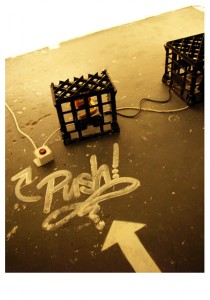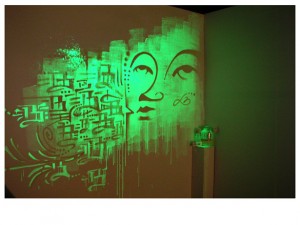While the practices of street art and new media seem poles apart, they’ve in fact been running parallel tracks for well over a decade. Both street art and new media have a strong history of subverting the mainstream – hacking, jamming, delivering DIY content and social conscience, an anonymous voice with a collective memory, appropriating advertising and political propaganda, kicking against monopolised media and creating an alternative dialogue, an alternate reality, a utopian space, a community space. A public space in the very truest sense of the term – that is, space that cannot be bought, that cannot be owned.
The interesting thing about street art and new media as artforms is that, generally, they are not created for sale. Nor are they considered “real art” like Painting, Sculpture, Theatre, Music or Literature. The artworks are barely tangible – fleeting, impermanent, transitional, site specific – it’s all about context. And when you’re working with binary code, aerosol, online environments, wheatpaste, avatars, stencils, mobile communications, and you put it out there – in the street – in the ether – what residue endures?
Street art and new media are two artforms whose longevity exists only in the memory of the viewer and in the documentation that is created. As a new media artsworker and street art fan, I am naturally drawn toward ephemeral items and the process of documentation (although ultimately documentation is still one generation removed from the original article). Nothing compares to the first hand delight, the serendipitous discovery of artwork that is available to you in the here and now, the knowledge that it may not exist tomorrow and therefore must be experienced in the moment. That is the beauty of ephemeral art.
Not everyone takes delight or sees the beauty in art in public space – especially without a permit; it seems people get rather passionate about concrete structures and who owns them. As co-curator of Broken Window Theory and Board Member of Bus Gallery in Melbourne, I once gave permission to an exhibiting artist (who had paid for the space with an Arts Grant from the Melbourne City Council) to install work on the exterior of the gallery. The time was during the 2006 Commonwealth Games. His medium was aerosol. He was arrested.
Meanwhile, huge multi-national companies are able to buy entire sides of 10 story buildings; even the clear blue sky is for sale if you’ve got enough cash. And it’s not so different in cyberspace. Watch closely as your “free” web space – Blogger, MySpace, Facebook – generates personally tailored advertising banners that reference keywords in your personal communications. Alarming! We live in an urban environment filled with billboards, banners and neon “corporate tags”.
However, there is a space between street and gallery and it’s up to artists to grab it when they can – if they really do want to pit themselves against corporate visual pollution. In May 2007, the Caught on Tape screen program of street art invited nine artists from Australia, Japan and the US to splash their art up on Melbourne’s biggest digital wall, the Federation Square Big Screen. For one month, Caught on Tape dominated a high profile space usually reserved for sport and advertising. This was negotiated public space within the neat confines of a frame; this time in the form of big, sexy technology… and no one was arrested. The content was much the same as that in the street, but apparently form counts for a lot.
I recently attended the Street Alliance forum, supported by Melbourne City Council, where one panelist recounted the prevalence of UV black-lit glowing ‘tags’ around night-time Paris – which begged the question: if your tag is in neon, does that somehow make it more legitimate than if it is scrawled in extra fat Posca? At a time when it is common practice for advertisers to masquerade as street art, it’s fun to see street art masquerade as advertising.
Street art using technology is largely in its infancy – but clever projects have already emerged. Traditionally, artists re-purpose tools (digital or analogue, and across all artforms) to create something brand new. Now GPS systems, mobile phones, online communities, laptops and data projectors are the potential tools of a new street art trade. Powerful gadgets fit into pockets and backpacks as easily as cans or markers. And if you’re graffing with light, what is the crime? The question is, can new media generate a new wave of street art and still retain a DIY anti-corporate ethic – especially considering the prohibitive cost of new technologies? After all, outdoor advertising is a shrewd investment… and true street art is a gift.
Charity Bramwell
Charity is an independent curator and producer. She cut her new media teeth at ANAT before moving to Melbourne to be with the street art. There, she curated Broken Window Theory and Caught on Tape. Currently, Charity is a board member of Bus Gallery and works at the University of Melbourne. She is sometimes known as ‘wideyedkid’.
Read More
 This work is licensed under a Creative Commons Attribution-NonCommercial-NoDerivs 2.5 Australia.
This work is licensed under a Creative Commons Attribution-NonCommercial-NoDerivs 2.5 Australia.









What vitriol is reserved for the street artist… lumped in as the scurge of all that is good and ordered in society. Responsible for the moral decay of good decent areas, destroyers of Utopia. People championing the "abuse" of others property ( I assume these nay-sayers also spend their weekend helping people weed their front yards and mend broken gates, and remove rubbish at their own expense…??? of course they do…?) is an inspiration. These people also see something we don't. The beauty of a stinking, dirty forgotten ally way, that has gone abused and forgotten until we found a use for it.
Sarcasm aside, (you may have missed it) I LOVE the balanced argument in Legal vs Moral. Street art may be illegal , but as you point out Charity, is it any less moral than advertising. Ads some times just occupy space that was otherwise unused, as does street art… though on MANY occasions it takes up vast spans of vista that were doing something else…billboards along train platforms where better views could be had.
There is no denying though that some take the forms of street art an apply them in a anti social way…perhaps those with untempered impulse control…much like some drivers…though driving is not banned or immoral
cheers WEK good article